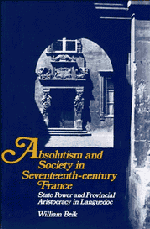 Absolutism and Society in Seventeenth-Century France
Absolutism and Society in Seventeenth-Century France Published online by Cambridge University Press: 05 July 2011
The social distribution of taxes discussed in chapter 11 is based on an analysis of the accounts of the diocese of Toulouse. Other dioceses would have similar articles with variations for the local items.
Table 14 shows the articles as they were listed in the account, with appropriate explanation. Of the total 317,995 livres imposed, 293,516 livres (92.3 percent) were provincial taxes, while 24,479 livres (7.7 percent) were added on by the diocese in the form of fees or local expenses. If we start with the sums added by the diocese, we can see from table 15 that most of them went directly into the pockets of the local notables. Some items did recompense local officers and notables for services rendered, but most of these services were only marginally useful, especially the 5,480 livres – almost 2 percent of the entire diocesan tax burden – which went for the banquets, refreshments, and stipends of the representatives who attended the annual assiette meeting.
What became of the ‘provincial’ funds?
1. The ‘traditional taille’ (aide, octroi, crue) was assigned by the crown to cover ‘ordinary’ expenses at the local level, notably the stipends of royal officers. The diocesan receivers themselves paid their own officers, the présidial and sénéchaussée judges, and certain functionaries of the universities of Toulouse and Montpellier.
To save this book to your Kindle, first ensure [email protected] is added to your Approved Personal Document E-mail List under your Personal Document Settings on the Manage Your Content and Devices page of your Amazon account. Then enter the ‘name’ part of your Kindle email address below. Find out more about saving to your Kindle.
Note you can select to save to either the @free.kindle.com or @kindle.com variations. ‘@free.kindle.com’ emails are free but can only be saved to your device when it is connected to wi-fi. ‘@kindle.com’ emails can be delivered even when you are not connected to wi-fi, but note that service fees apply.
Find out more about the Kindle Personal Document Service.
To save content items to your account, please confirm that you agree to abide by our usage policies. If this is the first time you use this feature, you will be asked to authorise Cambridge Core to connect with your account. Find out more about saving content to Dropbox.
To save content items to your account, please confirm that you agree to abide by our usage policies. If this is the first time you use this feature, you will be asked to authorise Cambridge Core to connect with your account. Find out more about saving content to Google Drive.